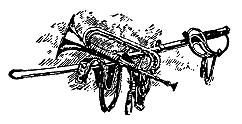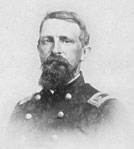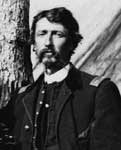

|
The remainder of the Union Army consisted of supporting units: cavalry, artilley and engineers.
Colonel Guy V. Henry commanded the Union cavalry brigade. This brigade included Colonel Henry's own Fortieth Massachusetts Mounted Infantry; the Independent Battalion Massachusetts Cavalry, commanded by Major Atherton Stevens; and Battery B, First United States Artillery, commanded by Captain Samuel Elder. |
Colonel Henry's mounted brigade, cavalry and artillery, had already seen action during the preliminary stages of the Florida Campaign and had performed well. The Union artillery were primarily regular army batteries — professionally trained, equipped, and led. These support units were far superior to the ill-equipped artillery and cavalry of the Confederates.
After the Battle of Olustee, the Independent Battalion Massachusetts Cavalry returned to duty with the Army of the Potomac, and its commander, Major Atherton H. Stevens, Jr., became provost marshal of the 25th Corps. On 3 April 1865, Major Stevens led two companies of the 4th Massachusetts Volunteer Cavalry into Richmond, Virginia, and was the first Federal officer to enter the city upon its fall. Major Stevens raised the guidons of the two companies over the Virginia Capitol Building, these being the first federal colors raised over the capital of the Confederacy.
 |
 |
 |
Captain Samuel Sherer Elder had previously served as an enlisted man in the U.S. Army artillery from 1853 to 1858, where he had advanced in rank from private to first sergeant. Upon the begining of the war, he was commissioned as a 2nd lieutenant and assigned to the 1st, and then the 4th U.S. Artillery. In May 1861, he was promoted to 1st lieutenant. In 1862, at Antietam, he was cited for gallantry and brevetted to captain. Elder's battery was involved in many of the cavalry actions during the Battle of Gettysburg, as well as some counter-battery duels. For his work there he was promoted to the permanent rank of captain on 1 August 1863. In fact, there is a monument to Elder's Battery atop Bushman's Hill on the battelfield.
In February 1864, he was detached to the Department of the South, where he commanded Battery B, First United States Artillery, also known as Elder's Horse Battery, during the Florida Expedition. Cited again for his actions at the Battle of Olustee, he was brevetted to major. In May, after returning to the Army of the Potomac, he was again cited for actions at Drewry’s Bluff in Virginia, and was brevetted lieutenant colonel. He remained in the army after the war, ending his career as a major. He died in 1885.
 |
|
Additional artillery support at Olustee was provided by Battery E, Third U.S. Artillery, commanded by Captain John Hamilton; Battery M, First U.S. Artillery, commanded by Captain Loomis L. Langdon; and Sections C and B of the Third Rhode Island Artillery, commanded by Lieutenant Henry H. Metcalf. Captain Loomis Langdon served at Pensacola at the beginning of the Civil War and later was in charge of the siege batteries duing the assault on Battery Wagner at Charleston on 18 July 1863. He was one of the two soldiers who lowered the Confederate flag and raised the American flag over the Confederate Capitol building in Richmond on 3 April 1865. Years later, he was the jailer of Geronimo . The Union guns, not including Elder's Horse Battery which was assigned to Coloney Henry's brigade, were commanded by Captain John Hamilton. In support of the Union artillery were Companies A and D of the 1st New York Volunteer Engineers. Lieutenant Colonel James F. Hall, also of the 1st Engineers, served as provost for the Department of the South. The 1st New York Engineers provided Companies A, D, G and I, commanded by Major James Place, in support of General Seymour's expedition. Upon arrival in Jacksonville, Companies A and D went to work repairing the railroad, and erecting gun batteries and rifle pits around Jacksonville. Companies G and I also built blockhouses and rifle pits, with Company G working between Jacksonville and Sanderson, and Company I toward Baldwin. Company G accompanied Seymour to Barber's Plantation on 11 February, and worked repairing the bridge over the Little St. Mary's River, which the retreating Confederates had partially destroyed during a skirmish on the 10th. The other three companies were occupied between Baldwin and Jacksonville, building defensive works. Some men were detached from their companies to serve with batteries of the 1st and 3rd U.S. Artillery. Four of these men were killed in action at Olustee. |
Captain Hamilton's Official Report of the Battle
Captain Landgon's Official Report of the Battle
Lieutenant Metcalf's Official Report of the Battle
Lieutenant Myrick's Official Report of the Battle
Letters from Captain L. Langdon, Battery M, 1st U.S. Artillery
Letters and history of Lt Tully McCrea, Battery M, 1st U.S. Artillery
Letter from LtCol James Hall, 1st New York Engineers
Letter from A. Clement, Independent Battalion Massachusetts Cavalry
Letter from Lt George Eddy, 3rd Rhode Island Artillery
First section from letter of Charles Remick, 40th Massachusetts, in the Boston Journal, 29 February 1864
Second section from letter of Charles Remick, 40th Massachusetts, in Boston Journal, 29 February 1864
Article for Chelsea Telegraph and Pioneer on Gainesville attack, 14 February 1864
Boston Herald article on 40th Massachusetts Mounted Infantry and Ambush at the St. Mary's River
Newspaper article praising the 40th Massachusetts Mounted Infantry
Boston Herald article, 1 March 1864. Olustee and the Capture of Gainesville
Chelsea Telegraph and Pioneer article on the Gainesville Raid
Article in Chelsea Telegraph and Pioneer on the death of John Lemont, Independent Battalion Massachusetts Cavalry, 26 March 1864
Excerpt from the book A History of The First Regiment of Massachusetts Cavalry Volunteers
Photographs of officers of the Independent Battalion Massachusetts Cavalry
Photograph of John Earl, Independent Massachusetts Cavalry Battalion
Photograph of Lt L. Dennis, Company K, 40th Massachusetts Mounted infantry
Photograph of Sergeant Oramel Scofield, Company F, 40th Massachusetts Mounted Infantry
Photograph of Lt Henry Metcalf, 3rd Rhode Island Artillery
Photograph of Lt Michael Leahy, Battery B, 1st U.S. Artillery
Short biography of Lt John Myrick, 3rd U.S. Artillery
Photograph of colors, Battery B, 1st U.S. Artillery
Sword belonging to 1st Lt Orson Baxter, Company M, Independent Massachusetts Cavalry Battalion
External Web sites related to the Battle of Olustee
History of the 1st New York Engineer Regiment
Short history of 1st New York Volunteers (engineers)
History of the 1st New York Volunteers (engineers)
Roster of the 1st New York Volunteers (engineers) PDF
History of the 40th Massachusetts Mounted Infantry
History of the Independent Massachusetts Cavalry Battalion
History of the 3rd Regiment Heavy Artillery, Battery C
History of the 1st U.S. Artillery, Battery B
Wikipedia page on Captain Samuel Elder, 1st U.S. Artillery
Florida Memory site on Colonel Loomis Langdon
History of the 1st U.S. Artillery, Battery M - Elder's Horse
History of the 1st U.S. Artillery, Battery E
Free online book - Personal Narratives: The Florida Campaign with Light Battery C, Third Rhode Island Heavy Artillery published 1905
?
Union Order of Battle
Battle of Olustee home page
http://battleofolustee.org/